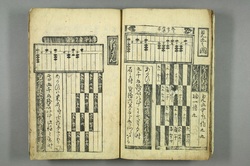 The abacus, or soroban 算盤
The abacus, or soroban 算盤 It is often said that mathematics is the only true universal language, and many different cultures have discovered many of mathematics theorems independently. Japan also has a rich history of developing its own mathematics. It was, as expected, developed from Chinese mathematics, but during the closed years of the Tokugawa period it developed more or less independently of external sources.A good place to start the story of traditional Japanese mathematics is the introduction of the soroban 算盤, or abacus, to Japan. It is believed that the first abacus was brought to Japan during Hideyoshi's unsuccessful invasion of Korea at the end of the sixteenth century. This is because the oldest surviving abacus that has been found in Japan was in the possession of one of Hideyoshi's soldiers at the port of Hakata around 1592. Usage of the soroban was popularized in great part by the mathematician Mōri Shigeyoshi who among other things published a primer on how to run divisions using the soroban.
 Two pages from Jinkō-ki
Two pages from Jinkō-ki Although Mōri Shigeyoshi and the introduction of the soroban had great implications for the development of Japanese mathematics, it is the publication of the book Jinkō-ki 塵劫記 in 1627 that is usually seen as the beginning of wasan 和算. Wasan is the term that is used to refer to traditional Japanese mathematics and will be used in this post hereon after. The term was not used until the Meiji period, and was then used in order to differentiate Japanese mathematics from western mathematics. The Jinkō-ki was published by the mathematician Yoshida Mitsuyoshi (1598-1672) and became a bestseller. It was revised and re-published in more than three hundred versions over the next three hundred years. This brought on a new culture of mathematics and more and more mathematical books and schools appeared all over the country. Although wasan might not have contributed much or anything to the development of international mathematics, Japanese mathematicians discovered many of the same things as western mathematicians, some things also before they were discovered in the west. For instance, the most famous Japanese mathematician, Seki Takakazu developed a theory of determinants before Leibniz. Also, Soddy's hexlet that was previously believed to have been discovered in the west in 1937, has been discovered on a tablet in Japan dating from 1822. For more detail on these matters see Chapter 8: East and West in the book Sacred Mathematics: Japanese Temple Geometry by Fukugawa Hidetoshi and Tony Rothman.
 Sangaku tablet
Sangaku tablet Perhaps the most interesting part of wasan, at least for a non-mathematician like me, is the tradition of sangaku 算額. Sangaku refers to tablets containing mathematical puzzles, most often of the geometrical type. These tablets were offered to Buddhist temples and Shinto shrines and hung there on display for other mathematicians to see. Usually the tablets also included the answer, but not the complete solution or proof. In this manner, they were also challenges to other mathematicians, basically saying "Prove this!", or "How can this be solved?". Mathematicians often published their solutions to problems made by others, and also published new problems for others to solve. Unfortunately, many tablets have not survived, but we know about the existence of many of them through collections of sangaku problems that were published in books in the Edo period. For instance, the mathematician Yamaguchi Kanzan travelled extensively throughout Japan and wrote a diary about his travels where he also wrote down sangaku problems that he encountered. Another book, dedicated only to sangaku problems, is the Shinpeki Sanpo 神壁算法 published in 1790 by Fujita Kagen. For an excellent collection of surviving sangaku tablets, visit http://www.wasan.jp/ .
 From Shinpeki Sanpo
From Shinpeki Sanpo The sangaku and many of the problems recorded in books are generally visually pleasing and should be treated as cultural treasures regardless of their mathematical relevance. Nevertheless, the tradition of wasan faced an abrupt end. With the modernizing of Japan in the Meiji period and the introduction of western mathematics, wasan was deemed inferior and was no longer to be taught in school. There seems to be quite an interest in the subject though, and people are playing around with the old puzzles. Although this post has focused on the culture of wasan, there might be people reading this who want to twist their brains and wrestle with these puzzles. If you're one of those, I recommend checking out the book mentioned earlier, Sacred Mathematics: Japanese Temple Geometry. It is stated in the book that it contains problems ranging from incredibly easy to impossible. You can also check out this link: http://www.wasan.earth.linkclub.com/english-nagano/english.html . If your browser has problems reading the characters, change the encoding to Japanese (Shift_JIS).
Sources and recommended reading
Fukagawa, Hidetoshi, and Tony Rothman. Sacred Mathematics: Japanese Temple Geometry. Princeton, N.J.: Princeton University Press, 2008.
Wikipedia (Jap)
http://www.wasan.jp/
Fukagawa, Hidetoshi, and Tony Rothman. Sacred Mathematics: Japanese Temple Geometry. Princeton, N.J.: Princeton University Press, 2008.
Wikipedia (Jap)
http://www.wasan.jp/
 RSS Feed
RSS Feed
